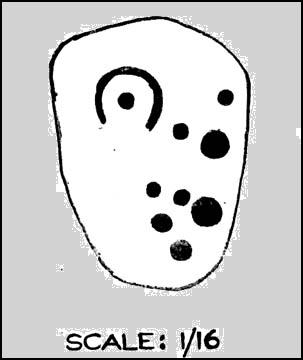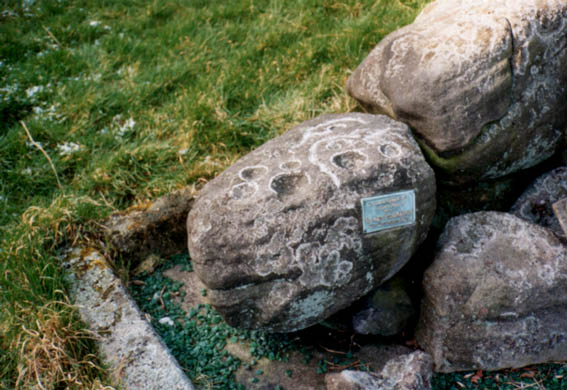Cup-and-Ring Stone: OS Grid Reference – SE 1774 4663
Also Known as:
- Carving no.568
Dead easy this. From Otley, take the north road over the River Wharfe and turn left following the signs to Askwith, where you’ll hit Weston village first. Once here, take the small left turn down to Weston Hall and the accompanying church. Go into the churchyard and check the graves!
Archaeology & History
This is a real curiosity. It’s found in the graveyard of All Saints church, Weston, where one of the graves has several small stones on it, with this small stone with the following cup-and-ring designs upon it. A plaque has been attached to it as a memorial to one ‘Susan Mary Dawson’. Strange…


It was first written about by Sidney Jackson (1957), but where it first came from and why it has been placed here in a christian setting is something of a mystery. It’s also odd inasmuch as although we know that there was some form of ritual or geomantic use of cup-and-rings in relation to neolithic and Bronze Age burials — that such a tradition has been performed by this particular family on this grave. It is obviously highly unlikely that this family had any knowledge whatsoever of burial traditions in relation to cup-and-ring art (please, shoot me down in flames if you know otherwise), so this re-use of this prehistoric stone is likely to be little other than fortuitous. But then, the occult history of some of the influential families in and around this region in relation to witchcraft, ancient kingship and esoteric practices, might indicate otherwise…
Does anyone know anything about the Dawson family history which might throw light on this modern use of a prehistoric tomb marker? It has all the hallmarks of once coming from a prehistoric cairn, but we know little of its history prior to 1957.
References:
- Boughey, Keith & Vickerman, E.A., Prehistoric Rock Art of the West Riding, WYAS 2003.
- Jackson, Sidney, ‘Cup-and-Ring Boulder, Weston Churchyard,’ in Cartwright Hall Archaeology Group Bulletin, 2:16, 1957.
© Paul Bennett, The Northern Antiquarian
The map could not be loaded. Please contact the site owner.
This is what I found with regard to the Dawson familie on the web:
“In 1284-5 the manor of Weston was held by William de Stopham for one fourth of a
knight’s fee of John de Vesci who held of the king. In 1315 William de Stopham (or his
son of the same name) is recorded in the Nomina Villarum as lord of the manor. Later
his daughter Alice married Sir Mauger de Vavasour and the manor was held by this
family for more than five centuries. In 1833 it passed by inheritance to the Carter
family and then, in 1852, to the Dawsons who continue to this day to reside at
Weston Hall.”
Hi Rockart –
Still makes you wonder why they had a cup-marked stone moved and placed onto the grave… It’s probably an issue we’ll never get to the bottom of.
All the best – Paul
Hi Paul,
I was intrigued by the last part of that web-contribution: “….to the Dawsons who continue to this day to reside at Weston Hall.”
Are you not tempted to knock on that door?
I will certainly do when in the area.
You’ll never know; just in case you don’t get an answer, you might get a cup of thee!
Cheers mate, keep on rocking!
Jan
Hi again Jan!
< I was intrigued by the last part of that web-contribution: “….to the Dawsons who continue to this day to reside at Weston Hall.” Are you not tempted to knock on that door? >
I’ll certainly ask at the vicarage when I’m next over that way. Hmmm…and I have been wondering where to take misself the last week or 2 for a venture around. I might travel over there – but will have to wait till the snow subsides a bit more (as much as I love snow, it hides all the rock-art!).
All the best – Paul
By chance I was out at Weston Church today and noticed said stone/rock/grave marker. Very intriguing.
Maybe they just liked the stone with its carvings, or they didn’t realise what the carvings were. Very strange none-the-less. Its amazing what you can find in old churchyards, isn’t it !